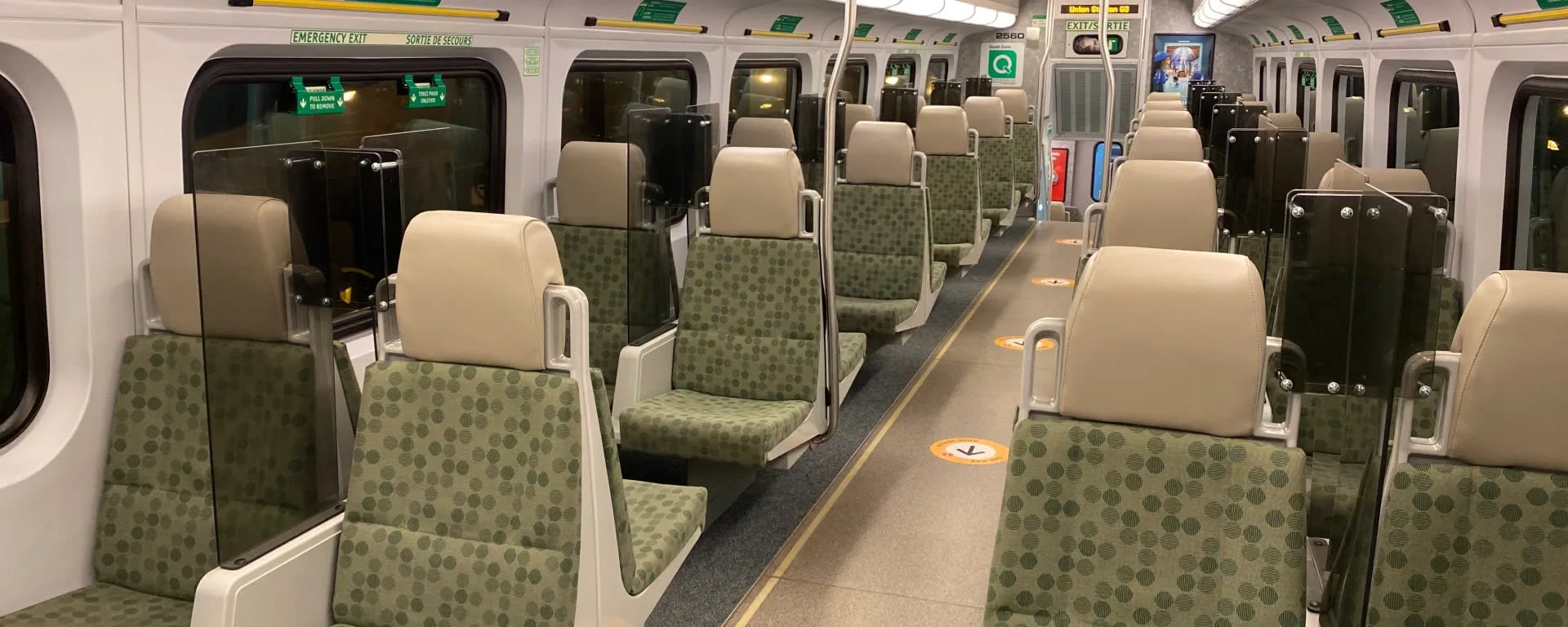Airflow on the GO: How Metrolinx keeps things fresh on trains
The transit agency explains how GO Transit keeps the air as freshly circulated as possible.
Aug 27, 2020
If you’ve been commuting during this pandemic or haven’t yet returned to transit, it must have crossed your mind; what kind of air am I breathing inside the coach?
It’s a valid question, one that’s also on the minds of dedicated transit crew and staff involved with GO Transit’s rail operations.
According to engineering and public health experts, increasing the amount of clean or outdoor air delivered to any area per hour reduces the risk of transmission of viruses through the air and therefore lowers the risk of contracting the disease.
Toronto Public Health recommends businesses increase air exchanges and use filters as they gear toward reopening.
Non-medical face coverings are mandatory on all GO Transit and UP Express vehicles and in stations. (Matt Llewellyn photo)
“It is important that businesses continue to follow good practices for HVAC systems and ensure ventilation and air exchanges are maintained,” said Dr. Vinita Dubey, Toronto’s associate medical officer of health, who spoke to the CBC on this topic.
Ensuring we maintain good air circulation on trains is just one way to limit the spread of transmission.
We have also implemented 40+ safety measures over the past six months to limit the spread and keep customers and staff safe.
Here’s how the air circulation system works.
Each bi-level train coach has two units – a heating ventilation and an air conditioning unit, also referred to as an HVAC unit.
The HVAC unit has two fresh air intake ducts and grilles, one return air grille and the main air supply duct.
Fresh air enters the HVAC system through grilles located on each side of the coach’s exterior.
The following graphic shows where the fresh air grills are located on the side of the coach. (Metrolinx photo)
Through the air ducts, the fresh air is directed into the HVAC unit where it passes through an air filter and enters the mixing plenum – a box that mixes the fresh air with the air drawn from the coach.
Here’s a closer look at what the HVAC unit looks like. Each car is equipped with two HVAC units per car with fresh air flowing at a rate of 600 cfm and supplying air flow at a rating of 2,950 cfm per unit. (Metrolinx photo)
The fresh air intake represents about 20 per cent of the air being continuously circulated at any given time in the interior of the car.
The remaining 80 per cent of the air is recycled, in fact, it’s impossible to have 100% fresh air as it would make for a very uncomfortable train ride.
The recycled air is needed to keep a moderate temperature in the car – otherwise the system would be trying to cool hot air or heat cold air – It simply wouldn’t make for a pleasant commute.
As for the filters, they are specifically designed to make sure the air is safe to breathe.
The fresh air from the outside goes through a MERV 13 filter, and then that air is recirculated inside the coach through a MERV 8 filter.
“The fresh air filters found in the HVAC units are the MERV 13 filters, typically used in hospitals and surgical rooms,” says Robert Fuller, Metrolinx director of rail services.
“We want our customers to take comfort in knowing the air they breathe in our coaches is filtered to the highest level possible, given the design of our current HVAC system.”
A closer look at the return air filters (MERV 8) used as part of the HVAC system. (Metrolinx photo)
Air is drawn from the passenger compartment through the return air grille located in the intermediate level ceiling, where the air passes through a MERV 8 filter and enters the HVAC unit mixing plenum to mix with the fresh air. (Metrolinx Photo)
The effectiveness of the ventilation system depends on how well it moves air. This can be calculated based on how frequently the air changes per hour (AC/h). In other words, calculating how many times the entire coach is supplied with air in an hour.
The air inside a GO train coach is replaced 10 times per hour with fresh air and 50 times per hour when mixing in recirculated air, a frequency that meets or exceeds public health guidelines.
GO Transit’s maintenance crews perform daily checks on HVAC systems inside the coaches to ensure they’re providing customers with the safest air possible.
Maintaining the highest air quality on trains is just one of the ways Metrolinx has been fighting the spread of COVID-19. Other measures include staff and customers wearing face coverings, the roll out of unique dividers between train and bus seats, and hand sanitizer dispensers in stations and onboard vehicles, as well as frequent vehicle and station cleaning that has staff constantly wiping down touch-points.
But safety doesn’t stop there.
The transit agency is continuing to monitor its air purification system closely, conducting feasibility studies to find out if there are any additional solutions that could add another level of air purification.
“We are continuing to determine if there are other technologies or systems that can further improve the ventilation system,” says Fuller.
“We want to give our customers as safe of a place to be as possible.”
So the next time you take a GO train, tap your PRESTO card, wear a face covering and just breathe – GO transit is doing everything to make sure your air is clean and safe.
To learn more about what you can expect when taking our service, click here.
by Nitish Bissonauth Metrolinx bilingual editorial content advisor
